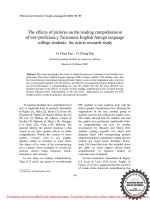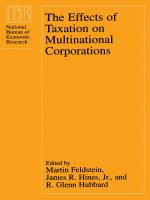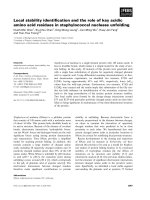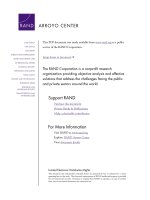Stability analysis to study the effects of different date of sowing on grain yield performance in wheat (Triticum sp.)
Bạn đang xem bản rút gọn của tài liệu. Xem và tải ngay bản đầy đủ của tài liệu tại đây (357.13 KB, 11 trang )
Int.J.Curr.Microbiol.App.Sci (2020) 9(5): 2343-2353
International Journal of Current Microbiology and Applied Sciences
ISSN: 2319-7706 Volume 9 Number 5 (2020)
Journal homepage:
Original Research Article
/>
Stability Analysis to Study the Effects of Different Date of Sowing on
Grain Yield Performance in Wheat (Triticum sp.)
Santoshkumar Pujer1*, V. Rudra Naik2, Suma S. Biradar2 and G. Uday2
1
SRF, AICRP on Wheat, 2Department of Genetics and Plant Breeding,
University of Agricultural Sciences, Dharwad 580005, (Karnataka), India
*Corresponding author
ABSTRACT
Keywords
Wheat, Stability,
G×E interaction,
Three dates of
sowing and grain
yield
Article Info
Accepted:
18 April 2020
Available Online:
10 May 2020
Genotype x Environment interaction effects and the stability for grain yield was determined by
evaluating eighteen wheat genotypes in three different sowing dates at AICRP on wheat, MARS,
University of Agriculture Sciences, Dharwad (Karnataka) during rabi 2017-18 under irrigated
conditions using a RCBD with two replications. The genotypes NIAW 34, HW 1098 and BMZ 1516-2 showed higher grain yield (2965.7, 3131.5 and 3037.7kg/ha), average responsiveness (bi = 1)
and non-significant S²di value which suggesting suitability of these genotypes for different dates of
sowing. The genotype HW 1098 exhibited superior performance for yield contributed by high tiller
under early sown conditions. The genotype HD 3090 recorded lower mean value with average
responsiveness (bi=1) indicating, poor adoptability to different dates of sowing and suitable only for
timely sowing. The genotypes, GW 322, UAS 415 and DDK 1029 showed higher mean values and
bi > 1 indicating sensitive to environmental changes and specific adaption to early sowing. The
genotypes BMZ 15-16-5 shows above average mean value and bi <1 indicated specific adoption to
only early sowing conditions. Results inferred that the genotypes namely NIAW 34, HW 1098 and
BMZ 15-16-2 suitable for all the three dates of sowing condition. It was also found that early sowing
is the most optimum time for sowing of wheat crop.
Introduction
Wheat (Tritium aestivum L.) is the second
most important crop that contributes
significantly to the global food and food
security (Singh, 2013). At global level, wheat
occupies an area of 221.68 mha, with a
production and productivity of 728.28 mt and
32.9 q/ha respectively. India’s share in world
wheat area is about 12.50 %, whereas it
occupies 12.05 % share in the total world
wheat production, which is the second largest
after China (USDA, 2016). In India wheat
occupies an area of about 31.23 mha with a
production of 98.38 mt. and average
productivity of 32.16 q/ha (Indian Institute of
Wheat and Barley Research Annual Report,
2017-18). Information about phenotypic
stability is useful for selection of crop
varieties in a breeding program. Plant
breeders encounter genotype × environment
2343
Int.J.Curr.Microbiol.App.Sci (2020) 9(5): 2343-2353
interaction (G × E) when testing varieties
across the different date of sowing. The
magnitude of the interaction or the differential
genotypic responses to environments differs
greatly across environments (Kaya et al.,
2002). The task of breeder is to screen out
genotype planted at different interval to
enable selection of those varieties, which are
suitable for wider range of planting. Hence a
study of genotype x environment interaction
can lead to successful evaluation of wheat
cultivars for stability in yield performance
across environments. The measure of the
relative performance of varieties under
different environments provides information
on stability pattern of these varieties.
Materials and Methods
Eighteen wheat genotypes viz., UAS 347, NI
5439, GW 322, UAS 304, HI 944, NIAW 34,
HD 3090, UAS 415, UAS 428, DDK 1025,
DDK 1029, HW 1098, BMZ 15-16-10, BMZ
15-16-5, BMZ 15-16-9, BMZ 15-16-2, BMZ
15-16-7, BMZ 15-16-6, were evaluated at
three different dates of sowing (October 25,
November 25 and December 25) at AICRP on
wheat, MARS, University of Agriculture
Sciences, Dharwad (Karnataka) during rabi
2017-18 for twelve characters viz., days to
anthesis, NDVI at anthesis, canopy
temperature at anthesis, chlorophyll at
anthesis, days to maturity, spike length,
number of spikelets, tillers per meter, grain
yield, biomass, 1000 grain weight and spike
length under irrigated conditions using a
RCBD with two replications.
GE interaction was analyzed using linear
regression techniques. Stability parameter was
estimated using the Eberhart and Russell
(1966) method. Two stability parameters i.e.,
regression coefficient (bi) and deviations from
regression (s2di) were worked out and tested
by using t-test and F-test separately from the
pooled analysis.
Results and Discussion
Pooled analysis of variance for grain yield
and yield related components across four
environments are presented in the Table 1
following Eberhart and Russell (1966) model.
The results revealed that there were
significant differences among the genotypes
tested at both 5 and 1 per cent level of
significance for all the characters studied. The
environment in which all the observations
were recorded also differed significantly (both
at 5 and 1% probability) to influence
significant variation in all the characters
recorded.
The mean squares due to genotypes were
highly significant against pooled error as well
as pooled deviation for various characters
except for 1000 grain weight under study
indicating sufficient genetic variability
present among the genotypes.
Environmental mean squares were also highly
significant except spike length and number of
spikelets against pooled error and pooled
deviation which indicated that environments
chosen in the study were highly variable.
Significance of E+ (G x E) interactions mean
square for most of the characters except days
to anthesis, spike length and number of
spikelets, tiller/m, 1000 grain weight and
grains/spike against pooled error and for all
the characters against pooled deviation
indicated presence of G x E interaction.
Mean square due to genotypes x environment
(linear) tested against pooled error were
significant for three characters viz., CT at
anthesis, grain yield (Kg/ha) and biomass
(Kg/ha). But were highly significant for all
the characters when tested against pooled
deviation. This indicated the preponderance
of linear component of G x E interaction was
higher than non-linear component hence,
predictions appeared possible.
2344
Int.J.Curr.Microbiol.App.Sci (2020) 9(5): 2343-2353
Environment (linear) were significant for all
the characters except spike length and number
of spikelets indicating significant differences
among genotypes in four environments. In
genotypes x environment (linear) portion was
higher in magnitude than non-linear (pooled
deviation) for CT at anthesis, grain yield
(Kg/ha) and biomass (Kg/ha), except for days
to anthesis, NDVI at anthesis, chlorophyll at
anthesis, days to maturity, spike length,
number of spikelets, tiller/m, 1000 grain
weight and grains/spike.
15-16-5 were found to have high mean value
and average response (bi = 1) indicating their
adoptability over all the environments. The
genotype BMZ 15-16-9 with below average
responsiveness indicated that specific
adaption
to
favorable
environmental
condition. The genotypes NAIW 34, UAS
415, DDK 1029 and BMZ 15-16-7 recorded
high mean value, bi< 1 and significant S²di
values indicated the presence of non-linear
portion of G x E interaction, which makes it
specifically adapted to unpredictable under
varying environment conditions.
Days to anthesis
The studies on estimate of stability
parameters revealed that none of the genotype
was stable for all the characters. The genotype
BMZ 15-16-2 shows stable characters which
had showed bi value close to unity (bi=1) and
non-significant
(S2di)
indicating
its
superiority for average response and stability
over all environment whereas, NI 5439, GW
322, HD 3090, UAS 428, DDK 1029, BMZ
15-16-10 and BMZ 15-16-7 were suitable for
favourable environment conditions and the
genotype, HW 1029 showed bi value close to
unity (bi=1) and non-significant (s2di) and
lower mean value indicating that poorly
adapted to all environmental condition for
days to anthesis. The results are in agreement
with Gulzar et al., (2015), Thakare et al.,
(2014), Yadava (2003) who reported
significance of both linear and non-linear
components and indicated the presence of
both
predictable
and
unpredictable
components of G×E. Thakare et al., (2014)
and Kashte (2013) has reported the
predominance of linear and non-linear
components which are in agreement with the
present findings.
NDVI at anthesis
Among stable genotypes, the genotypes, DDK
1025, HW 1098, BMZ 15-16-10 and BMZ
Remaining all the genotypes was found to be
unadapted to tested environments. The
genotypes viz., GJHV 500 and F 2177 were
found to have earliness and average response
(bi = 1) indicated their adoptability over all
the environments. The genotype GW 322
shows average responsiveness and lower
mean value indicating that poorly adapted to
all environmental conditions.
CT at anthesis
The out of eighteen genotypes five genotypes
viz., GW 322, HD 3090, UAS 415, UAS 428
and BMZ 15-16-6 possessed above average
mean with bi> 1 indicating their suitability to
favourable environments. The genotype HW
1098 shows higher average mean value and
non-significant for both bi and S²di indicating
suitability for unfavourable environmental
condition.
Chlorophyll at anthesis
The genotypes, BMZ 15-16-10 and BMZ 1516-7 had above average mean values with bi>
1 indicated Specific adaption to favorable
environments. The genotypes, NI 5439, UAS
415 and BMZ 15-16-9 recorded highest mean
value with above average responsiveness
(bi<1) indicated it’s specific adaption to
unfavorable environments.
2345
Int.J.Curr.Microbiol.App.Sci (2020) 9(5): 2343-2353
Days to maturity
The genotype BMZ 15-16-10 exhibited higher
mean value and bi =1 indicating their average
stability over all environments. The lines viz.,
UAS 415 and UAS 428 had high mean value
with regression coefficient less than unity
indicating their adaptability to tested
environments. Whereas, the genotype, BMZ
15-16-9 recorded above average mean value
for this character with bi> 1 indicating that
these are sensitive to environmental changes
but adapted to favourable environments. The
genotype HW 1098 shows average
responsiveness and lower mean value
indicating that poorly adapted to all
environmental conditions.
Spike length (cm)
The genotype, BMZ 15-16-6 depicted above
average mean value and bi > 1 indicating their
specific
adaptability
to
favorable
environments. The genotypes UAS 304, BMZ
15-16-10, BMZ 15-16-9 and BMZ 15-16-7
shows above average mean value and bi<1
indicated specific adoption to unfavourable
environmental conditions. These results are in
agreement with those obtained by Menshawy
(2007).
Number of spikelets
Genotypes HD 3090, BMZ 15-16-7 and BMZ
15-16-6 depicted above average mean value
and bi > 1 indicated their specific adaption to
favorable environments. The genotypes GW
322, UAS 304, BMZ 15-16-10 and BMZ 1516-2 shows above average mean value and
bi<1 indicated specific adoption to
unfavourable environmental conditions.
Number of tillers/m
The out of eighteen genotypes, DDK 1029
and HW 1098possessed above average mean
with bi> 1 indicating their suitability to
favourable environments. The genotypes
viz.,BMZ 15-16-9, and BMZ 15-16-2 shows
higher average mean value and nonsignificant for both bi and S²di indicating
suitability for unfavourable environmental
condition The results are in agreement with
Gulzar et al., (2015), Thakare et al., (2014),
Yadava R. (2003).
Grain yield (kg/ha)
As regard of grain yield, genotypes as well as
genotypes and environment interaction was
non-significant, indicating no genetic
difference
among
genotypes
for
environmental response. The genotype BMZ
15-16-9
with
highest
mean
value
(3255.33Kg/ha) showed the presence of only
non-linear portion of G X E interaction which
makes its performance unpredictable under
varying environments. Among three stable
genotypes viz., NIAW 34, HW 1098 and
BMZ 15-16-2 possessed above average mean
value with regression coefficient bi = 1
indicating their adoptability to different
environments Similar trends have been
reported in other multi-locations or multi
environments field experiments by Yan et al.,
(2010) and Rakshit et al., (2012), Motamedi
et al., (2012), Kant et al., (2014), Thakare et
al., (2015), Lodhi et al., (2015). HD 3090
were found to have low mean value and
average response (bi = 1) indicating their
poorly adoptable to all the environmental
conditions. Similar findings were also
reported by Gowda et al., (2010), Meena et
al., (2014), Singh and Tyagi (2014) and
Kumar et al., (2014). The genotypes GW 322,
UAS 415 and DDK 1029 recorded high mean
values with above average response (bi> 1)
indicating their suitability to favourable
environments. The genotype, BMZ 15-16-5
possessed bi< 1 and above the mean value
indicated
that
specific
adoption
to
unfavourable environmental conditions.
2346
Int.J.Curr.Microbiol.App.Sci (2020) 9(5): 2343-2353
Biomass (kg/ha)
The genotypes NI 5439, GW 322, UAS 304,
UAS 415, DDK 1029 and HW 1098 depicted
above average mean value and bi > 1
indicating their specific adaptability to
favorable environments. The genotypes NI
5439 with high biomass (kg/ha) significant
responsiveness (bi> 1) indicating that
adoptability to favorable environments.
The genotypes HD 3090 and UAS 428
possessed below average mean and bi = 1
indicating poorly adaptability to all the
environments. The genotype BMZ 15-16-10
depicted above average mean value and bi = 1
indicated well adaptability to all the
environments. The genotypes BMZ 15-16-5,
BMZ 15-16-7 and BMZ 15-16-6shows above
average mean value and bi<1 indicated
specific
adoption
to
unfavourable
environmental conditions.
1000 grain weight (g)
The joint regression analysis (Table 1)
showed t highly significant GE interaction.
The heterogeneity of regression Ms was not
significantly against the error, whereas, the
remainder from regression Ms was highly
significant
indicating
that
non-linear
component of GE interaction was operating.
Kaya et al., (2002) reported that there were
significant differences between wheat
genotypes as well as GE in yield and yield
components; a genotype with the lowest or
non-significant deviation from regression
being the most stable. The only one genotype,
viz., HD 3090 has higher mean value, average
responsiveness (bi=1) indicating their
adoptability to all the four environments.
Similar finding was reported by Meena et al.,
(2014) and Kumar et al., (2014). The
genotype DDK 1025 showed significant
regression coefficient deviating from unity
indicating unpredictable performance of these
genotypes across the environment. The other
set of genotypes viz., UAS 347, NI 5439, GW
322, HI 944, UAS 428, DDK 1029, BMZ 1516-5, BMZ 15-16-2, BMZ 15-16-7 and BMZ
15-16-6 were found to be unstable for
expression of this trait.
The genotype, NIAW 34 recorded lower
mean value with average responsiveness (bi =
1) indicating, poorly adoptable to all the four
environments. The genotypes, UAS 415 were
found having high mean value and bi<1
indicated specific adaption to unfavourable
environmental conditions.
The genotypes, UAS 304, HW 1098 and
BMZ 15-16-10shows higher mean value and
bi> 1 (below average) indicated specific
adaption to favorable environments. Similar
findings were reported by Sharma et al.,
(2012), Swami (2012), Arain et al., (2011),
Al-Otayk (2010) Aydin et al., (2010) Kirigwi
et al., (2004) and Sial et al., (2000).
Grains/spike
The genotype, BMZ 15-16-6 exhibited higher
mean value and bi =1 indicating their average
stability over all environments. The lines viz.,
UAS 347, NI 5439, BMZ 15-16-5 and BMZ
15-16-2 had high mean value with regression
coefficient less than unity indicating their
adaptability to tested environments. The
genotype (BMZ 15-16-6) with more number
of grains/spike (56.83), bi = 1 and nonsignificant for S²di value indicated that
suitability in all types of environments similar
report obtained by El-Morshidy (2001) and
Abdel-Majeed (2005).
Whereas, the genotype UAS 304 recorded
above average mean value for this character
with bi> 1 indicating that these are sensitive to
environmental changes but adapted to
favourable environments (Table 2–5).
2347
Int.J.Curr.Microbiol.App.Sci (2020) 9(5): 2343-2353
Table.1 Analysis of variance for stability parameter of seed cotton yield and important yield components (Eberhert and Russell, 1966)
Sources of variance
DF
Days to
anthesis
NDVI at
anthesis
CT at
anthesis
Chlorophyll
at anthesis
days to
maturity
Varieties
Env.+ (Var.* Env.)
Environments (Lin.)
Var.* Env.(Lin.)
Pooled Deviation
Pooled Error
17
36
1
17
18
51
48.03 ***
12.389
141.73 ***
9.39
8.03***
1.063
0.003*
0.003**
0.094***
0.001
0.001**
0
1.74**
1.77 **
33.12***
1.28*
0.49**
0.20
8.84**
5.61**
43.29***
6.42
2.74***
0.65
44.502**
31.204**
692.36***
13.949
10.77***
1.195
spike
length
(cm)
5.73***
0.26
0.41
0.13
0.39***
0.07
No. of
spiklets
tillers/m
Grain yield
(Kg/ha)
Biomass
(Kg/ha)
1000 GW
(g)
Grain/
Spike
9.68***
0.84
0.47
0.46
1.21***
0.32
280.75**
88.51
456.23 *
77.70
78.28***
5.45
92362.18**
481782.8 ***
15751650.00***
68702.910*
23588.08**
8697.12
548024.4***
460191.8***
12820730***
150379.1*
66096.16**
39592.13
5.567
16.535
167.00***
13.74
10.81***
0.62
69.84***
16.181
232.62 ***
6.00
13.76 ***
3.06
Table.2 Estimates of stability parameters of individual genotypes for days to anthesis, NDVI at anthesis and CT anthesis
S.N
Genotypes
1 UAS 347
2 NI 5439
3 GW 322
4 UAS 304
5 HI 944
6 NIAW 34
7 HD 3090
8 UAS 415
9 UAS 428
10 DDK 1025
11 DDK 1029
12 HW 1098
13 BMZ 15-16-10
14 BMZ 15-16-5
15 BMZ 15-16-9
16 BMZ 15-16-2
17 BMZ 15-16-7
18 BMZ 15-16-6
Population mean
Mean( )
62.50
69.16
67.833
71.16
59.16
59.33
69.50
69.50
68.83
70.50
69.50
66.66
68.50
61.33
69.83
68.16
69.66
72.16
67.40
Days to anthesis
bi
-1.134
1.255
2.07
1.837
-0.835
-1.219
1.461
0.243
2.07
1.49
1.265
0.898
1.621
0.354
1.435
1.077
1.92
2.193
S2di
4.325*
-0.776
0.374
7.055**
20.624***
19.911***
0.158
-1.013
0.374
9.961**
-0.141
1.265
2.763
19.134***
28.901***
-0.006
-0.897
13.748***
NDVI at anthesis
bi
S2di
Mean( )
0.59
0.869
0.0004
0.56
1.343
-0.0003
0.59
0.993
0.0001
0.59
1.508
0.0003
0.64
1.097
0.0019 *
0.62
0.756
0.0004
0.60
0.504
0.0029 **
0.62
0.429
0.0000
0.58
0.951
0.0021 **
0.67
0.924
0.0007
0.67
0.802
0.0003
0.64
1.026
0.0003
0.62
1.049
0.0001
0.62
0.958
0.0003
0.62
1.132
-0.0003
0.60
1.446**
-0.0003
0.63
0.591
-0.0001
0.60
1.621
0.0010
0.61
2348
Mean(
25.46
26.91
26.60
26.21
25.11
24.98
25.81
26.53
25.9
25.21
24.58
26.45
24.86
24.65
25.16
25.16
26.81
25.78
25.68
CT at anthesis
bi
)
1.993
1.88
1.217
1.72**
1.362
-0.34
1.984
1.399
1.147
-0.712
0.392
0.544
-0.238
0.466
1.339
1.628
0.593
1.626
S2di
-0.064
1.358*
-0.026
-0.239
0.351
1.274*
0.044
0.082
-0.127
0.18
0.599
-0.139
-0.212
0.206
-0.177
0.615
1.066*
-0.233
Int.J.Curr.Microbiol.App.Sci (2020) 9(5): 2343-2353
Table.3 Estimates of stability parameters of individual genotypes for chlorophyll at anthesis, days to maturity and spike length (cm)
S.N
Genotypes
Chlorophyll at anthesis
Mean( )
Days to maturity
S2di
bi
Mean( )
bi
Spike length (cm)
S2di
Mean( )
bi
S2di
1 UAS 347
49.75
0.091
1.028
89.33
0.262
12.322**
8.15
1.917
-0.042
2 NI 5439
51.45
-0.335
-0.603
96.00
0.814
9.79**
7.26
2.765
0.69**
3 GW 322
48.56
3.818
-0.503
91.33
1.181
9.833**
8.26
0.472
-0.023
4 UAS 304
48.6
2.621
2.688*
98.33
1.89
7.52**
9.12
-0.168
-0.063
5 HI 944
48.36
-0.9
4.585**
86.00
-0.018
-0.721
7.26
-0.809
0.008
6 NIAW 34
50.10
-1.111
0.629
86.00
0.107*
-1.145
7.23
0.267
0.021
7 HD 3090
49.73
1.539
1.269
95.66
0.926
15.963***
8.20
-0.468
0.071
8 UAS 415
53.08
-2.543
-0.061
94.83
0.419
2.21
6.31
8.182
0.799***
9 UAS 428
50.12
1.289
-0.428
94.33
0.58
-0.961
5.10
-1.812
0.402**
10 DDK 1025
51.15
1.059
1.952*
97.16
1.818
49.821***
7.90
2.478
2.817***
11 DDK 1029
52.73
3.711*
-0.613
96.50
1.865
39.504***
8.55
2.385
0.203*
12 HW 1098
51.30
2.572 20.488***
91.50
1.063
0.796
8.43
-0.275
0.661**
13 BMZ 15-16-10
54.30
1.876
0.452
94.50
0.993
-1.135
10.10
0.604
-0.012
14 BMZ 15-16-5
48.98
1.149
0.76
88.16
0.84
-1.151
8.15
2.86
-0.063
15 BMZ 15-16-9
52.97
0.855
-0.024
97.33
1.715
2.306
10.43
-0.941
-0.037
16 BMZ 15-16-2
49.65
0.73
4.102**
91.66
0.962
6.34*
10.55
-2.114
0.57**
17 BMZ 15-16-7
50.88
1.275
0.321
93.50
0.921
8.181**
9.25
0.37
-0.062
18 BMZ 15-16-6
50.98
0.306
1.943*
96.33
1.663
12.609**
8.83
2.289
-0.056
Population mean
50.70
93.25
2349
8.28
Int.J.Curr.Microbiol.App.Sci (2020) 9(5): 2343-2353
Table.4 Estimates of stability parameters of individual genotypes for Number of spikelets, no. tiller/m and grain yield (Kg/ha)
S.N
Genotypes
No. Tillers/m2
Number of spikelets
Mean( )
bi
S2di
Mean( )
Grain yield (Kg/ha)
bi
S2di
Mean( )
bi
S2di
1 UAS 347
17.56
3.77
-0.163
68.66
1.547
45.588**
2618.33
0.938
82760.102**
2 NI 5439
18.93
4.169
-0.286
76.83
-1.555
33.985*
3070.00
1.281*
-10101.34
3 GW 322
22.06
-4.768
-0.185
78.66
3.099
211.916***
3162.00
1.231
14466.395
4 UAS 304
20.83
-4.893
0.204
94.00
0.081
228.437***
3129.00
1.293**
-10149.625
5 HI 944
17.60
6.816
1.413*
69.33
0.673
97.786***
2747.83
0.69*
-10050.722
6 NIAW 34
16.96
-0.125
0.845
65.00
-2.161
146.277***
2965.67
0.99
-10060.895
7 HD 3090
20.40
2.846
-0.271
72.33
1.611
-5.53
2804.17
0.97
4855.796
8 UAS 415
18.83
10.311
1.165*
78.66
0.866
18.277*
3038.33
1.28
6874.943
9 UAS 428
17.80
3.745
0.055
83.33
1.539
176.702***
2662.17
0.711
32333.943*
10 DDK 1025
21.61
-3.383
2.213**
74.33
3.419
13.991
2892.83
1.637
26902.873
11 DDK 1029
22.43
-3.545
5.159***
82.66
3.912
0.925
3090.17
1.173
-6040.389
12 HW 1098
19.38
3.308
1.996**
82.33
1.242
-0.356
3131.50
1.016
5131.91
13 BMZ 15-16-10
21.06
-1.398
0.055
62.50
-1.732
14.105
2901.67
0.802
16966.899
14 BMZ 15-16-5
18.76
3.245
0.072
72.50
1.343
35.919*
3014.17
0.734
5538.952
15 BMZ 15-16-9
21.63
-1.448
3.011**
94.16
0.164
16.585
3255.33
1.043
121174.382***
16 BMZ 15-16-2
22.30
-3.52
0.937
91.83
-0.301
-2.023
3037.67
0.991
-9253.291
17 BMZ 15-16-7
21.13
1.248
0.145
71.33
3.215
20.356*
2990.17
0.59*
-9943.305
18 BMZ 15-16-6
Population mean
20.83
20.00
1.623
-0.223
66.16
76.92
1.038
249.977***
2859.50
2965.02
0.63*
-9603.431
2350
Int.J.Curr.Microbiol.App.Sci (2020) 9(5): 2343-2353
Table.5 Estimates of stability parameters of individual genotypes for Biomass (Kg/ha), 1000 Grain Weight (g) and Grain/ spike
S.N
Genotypes
Biomass (Kg/ha)
1000 Grain Weight (g)
Mean ( )
bi
S2di
bi
S2di
1 UAS 347
4224.83
1.574
176654.997*
40.00
1.506
33.797***
2 NI 5439
5660.67
1.237
-27932.936
40.43
2.142
3 GW 322
5611.83
1.129
-20301.284
41.16
4 UAS 304
5519.00
1.398
24950.999
5 HI 944
4792.83
0.886
6 NIAW 34
5192.00
7 HD 3090
Grain/ spike
bi
S2di
54.16
0.793
-0.877
6.127**
52.33
0.402
7.154
3.254
3.481*
54.33
0.403
12.143*
41.13
2.14
-0.144
51.83
1.587
1.712
-20091.641
40.86
0.459
32.267***
49.00
1.189
3.32
0.884
-19889.289
39.83
0.906
-0.135
48.33
0.393
7.253
4823.67
1.064
46344.93
41.68
1.054
-0.524
53.00
2.377
22.044**
8 UAS 415
5528.83
1.451
-25125.173
42.25
-0.001
-0.197
50.66
2.826
70.026***
9 UAS 428
5082.17
0.912
-31463.045
39.15
0.208
5.627**
44.33
0.734
3.275
10 DDK 1025
4792.83
1.87
154466.576*
40.15
-0.877*
-0.515
43.16
0.964
-1.756
11 DDK 1029
5591.33
1.1
-38048.299
40.35
-1.27
8.54***
49.33
1.425
11.987*
12 HW 1098
5637.83
1.159
-11342.185
42.68
1.174
-0.104
47.33
1.078
-2.781
13 BMZ 15-16-10
5388.17
1.039
-24616.196
43.06
1.192
1.432
59.83
0.574
14.984*
14 BMZ 15-16-5
5888.17
0.846
-34855.891
41.16
-0.6
5.674**
52.66
0.626
-1.822
15 BMZ 15-16-9
5783.00
0.67
348853.301**
41.71
1.092
-0.591
62.16
0.465
46.951***
16 BMZ 15-16-2
5269.50
0.492
-37160.584
37.75
1.834
5.397**
52.50
0.684
-0.959
17 BMZ 15-16-7
5490.50
0.412
-39967.628
42.53
2.817
20.945***
49.33
0.567
-2.405
18 BMZ 15-16-6
5306.50
-0.122
8946.96
42.28
0.971
62.868***
56.83
0.913
4.978
Population mean
5310.20
Mean ( )
41.07
2351
Mean ( )
51.73
Int.J.Curr.Microbiol.App.Sci (2020) 9(5): 2343-2353
The present study suggest that October 25 is
the most optimum time of planting of wheat
crop, because the crop sown on October 25
produced the maximum grain yield, number
of tillers per meter row and grains per spike.
The rate of reduction after October 25
planting for grain yield, number of grain per
spike, 1000 grain weight and number of tiller
per meter row. Similar findings were reported
by earlier research workers Chaudhry et al.,
(1995), Iqbal et al., (2001) and Ahmad et al.,
(1996). The wheat variety BMZ 15-16-2 is
most stable for grain yield, tillers/m2, number
of spikelets, grains per spike, early maturity
and spike length and HW 1098 most stable
for tillers /m2, 1000 grain weight, high
biomass and days to maturity.
References
Abdel-Majeed SA, Mousa AM, Abd ElKareem AA (2005). Effect of heat stress
on some agronomic of bread wheat
[Triticum aestivum] genotypes under
Upper Egypt conditions. Fayoum. J.
Agric. Res. Dev. 19(1):4-16.
Ahmad, J., Chaudhry, M.H., Din, S. and Ali,
M.A. (1996). Stability for grain yield in
wheat. Pakistan J. Bot., 28: 61–5
Al-Otayk, M. S. (2010). Performance of Yield
and Stability of Wheat Genotypes under
High Stress Environments of the
Central Region of Saudi Arabia. Met.,
Environment & Arid Land Agriculture
Science, 21(1): 81-92.
Arain, A. M., Sial, A. M., Rajput, A. M. and
Mirbahar, A. A. (2011). Yield stability
in bread wheat genotypes. Pakistan J.
Bot, 43(4): 2071-2074.
Aydin, N., Bayramoglu, H. O. and Ozcan,
F.L. (2010). Stability of some quality
traits in bread wheat (Triticum
aestivum) genotypes. Journal of
Environment Biology, 31: 489-95.
Chaudhry, M.H., Anwar, J., Hussain, F. and
Khan, F.A. (1995). Effect of planting
time on grain yield in wheat varieties. J.
Agric. Res., 33: 103–8.
Eberhart, S. A. and Russel, R. A. (1966).
Stability parameters for comparing
varieties. Crop Sci., 6: 36-40.
El-Morshidy MA, Kherialla KA, Abdel-Ghan
AM, Abdel –Kareem (2001). Stability
analysis for earliness and grain yield in
bread wheat the 2 plant Breed comp.
October 2, Assiut, University, pp. 199 -217.
Gowda, D., Singh, S.S., Singh, G.P.,
Deveshwar, A.M., and Ahlawat, A.
(2010).
Stability
analysis
for
physiological and quality parameters in
wheat (Triticum aestivum). Indian J. of
Agri. Sci, 80(12):102832.
Gulzar, S., Kamaluddin, Bhatt, M. A., Yusuf,
N. and Khan, M. A. (2015). Stability
analysis for yield, yield component and
quality traits in wheat (Triticum
aestivum L.) under temperate conditions
in kashmir valley. Plant Archives., 15:
433-440.
IIWBR, (2016). Annual Report of Indian
Institute of wheat and barley Research.
Iqbal, M.S., Yar,A., Ali, A., Anser, M.R.,
Iqbal, J. and Akram, M.H. (2001).
Effect of sowing dates and seed rate on
grain yield of wheat (CV.93-BT-022). J.
Agric. Res., 39: 217–21.
Kant, S., Lamba, R. A. S, Arya, R.K. and
Panwar, I.S. (2014). Effect of terminal
heat stress on stability of yield and
quality parameters in bread wheat in
south-west Haryana. J. of Wheat Res.,
6(1):64-73.
Kashte S. (2013) “Stability analysis for yield
and quality traits in wheat” (Triticum
aestivum L.) Thesis submitted to
V.N.M.K.V. Parbhani.
Kaya N, Paita C, Taner S (2002). Additive
main
effects
and
multiplicative
interaction
analysis
of
yield
performance in bread wheat genotypes
across environment. Turk. J. Agric.
26:275-279.
2352
Int.J.Curr.Microbiol.App.Sci (2020) 9(5): 2343-2353
Kirgiwi, F.M., Ginkel, M. V., Trethowan, R.,
Sears, R. G., Rajaram, S. and Paulsen,
G. M. (2004) Evaluation of selection
strategies for wheat adaptation across
water regimes. Euphytica, 135: 361-71.
Kumar, V., Tyagi, B.S., Verma, A. and
Sharma, I. (2014). Stability analysis for
grain yield and its components under
different moisture regimes in bread
wheat (Triticum aestivum). Indian J. of
AgriSci, 84(8): 931-6.
Lodhi, R. D., Prasad, L. C., Bornare, S. S.,
Madakemohekar, A. H., And Prasad,
R.(2015). Stability analysis of yield and
its component traits of barley (Hordeum
vulgare l.) genotypes in multienvironment trials in the north eastern
plains of india. J. of Breeding and
Genetics., 47(2): 143-159.
Meena, H.S., Kumar. D,, Srivastava, T.K. and
Rajendra, P.S. (2014). Stability for
grain yield and its contributing traits in
bread wheat (Triticum aestivum). Indian
J. of AgriSci, 84(12): 1486-95.
Menshawy, A.M.M. (2007) Evaluation of
some early bread wheat genotypes
under different sowing dates:1 Earliness
characters.
Fifth
plant breeding
conference (May), Egypt J. Plant Breed,
11(1): 25-40.
Motamedi, M., Naserierad, H., Naseri, R. and
Soleymanifard, A. (2012). Assessment
of genotype × environment interaction
for grain yield in bread wheat
genotypes. Intl J. of Agri Crop Sci.,
4(18): 1366-1370.
Sharma, C. R., Morgounov, I. A., Braun, J.
H., Akin, B., Keser, M., kaya, Y.,
Khalikulov, Z., Ginkel, M., Yahyaoui,
A. and Rajaram, S. (2012). Yield
stability analysis of winter wheat
genotypes targeted to semi-arid
environments in the international winter
wheat
improvement
program.
International J. of Plant Breeding,
6(1):7-13.
Sial, A. M, Arain, A. M. and Ahmad, M.
(2000). Genotype x environment
interaction on bread wheat grown over
multiple sites and years in Pakistan.
Pakistan J. Bot, 32(1) 85-91.
Singh, T. and Tyagi, J.P. (2014). Stability for
Yield and its Component Traits in Durum
Wheat (Triticum durum Desf.). Indian J.
of Plant Genetic Res, 27 (3): 287-94.
Swami, A. 2012. Stability analysis for
different quantitative and physiological
traits in bread wheat. M.Sc. thesis. Sam
Higginbottom
University
of
Agriculture, Technology and Sciences,
Allahabad, India.
Thakare, S. D., Potdukhe, N. R. and Bharad,
S. G (2014). Yield Stability over
Sowing Windows in Wheat. J. of
pkvresearch., 38(2): 30-36.
Yadav, R. and Singh, T. B. (2003). Stability
analysis in wheat for grain protein.
Indian J. of Genetics., 63(4): 337-338.
Yan, W., Fregeau-Reid, J., Pageau, D.,
Martin, R., MitchellFetch, J., Etienne,
M., Rowsell, J., Scoot, P., Price, M.,
Haan, B., Cummiskey –Alajeunesse, J.,
Durand, J., Sparry, E. (2010).
Identifying essential test locations for
oat breeding in eastern Canada. Crop
Sci, 60: 504-515.
How to cite this article:
Santoshkumar Pujer, V. Rudra Naik, Suma S. Biradar and Uday, G. 2020. Stability Analysis to
Study the Effects of Different Date of Sowing on Grain Yield Performance in Wheat (Triticum
sp.). Int.J.Curr.Microbiol.App.Sci. 9(05): 2343-2353.
doi: />
2353









